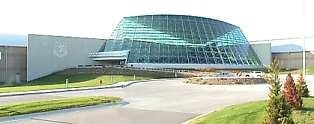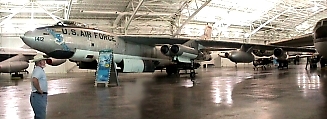Strategic Air Command Museum
Omaha Nebraska
October 27th, 1998
As we traveled along I-80 out of Iowa, heading for Omaha we passed exit 426,
 just west of the city. It was time for some nostalgic remembrance of those early
days of my life as an older teenager freshly enlisted in the Air Force. I had joined
to see the world but all they did was hand me a rifle and put me under a plane that
I would become all too familiar with over the next four years; the wonderfully
versatile and immensely popular B-47 bomber. I had spent 4 years, both here and
in England guarding this bird, day and night, rain and snow. My legs still bear
the scars of frostbite received on one those nights when I was without proper raingear.
It was the cold war, and Gen. Curtis LaMay had been put in charge of the
most advance nuclear war deterrent yet devised by man. The Strategic Air
Command. Its short lived but colorful history forever a part of my memories.
The mighty B-47 who’s numbers swelled to over 4,000 at its peak, was the main
stay. Now, long since deactivated, this workhorse no longer flies, replaced by the
B-52 and the ICBM. I couldn’t help smiling as I found myself standing in front
of this gracious lady in the main hanger.
The Strategic Air Command (SAC) Museum stands as a tribute to the men and
women of SAC who safeguarded liberty
just west of the city. It was time for some nostalgic remembrance of those early
days of my life as an older teenager freshly enlisted in the Air Force. I had joined
to see the world but all they did was hand me a rifle and put me under a plane that
I would become all too familiar with over the next four years; the wonderfully
versatile and immensely popular B-47 bomber. I had spent 4 years, both here and
in England guarding this bird, day and night, rain and snow. My legs still bear
the scars of frostbite received on one those nights when I was without proper raingear.
It was the cold war, and Gen. Curtis LaMay had been put in charge of the
most advance nuclear war deterrent yet devised by man. The Strategic Air
Command. Its short lived but colorful history forever a part of my memories.
The mighty B-47 who’s numbers swelled to over 4,000 at its peak, was the main
stay. Now, long since deactivated, this workhorse no longer flies, replaced by the
B-52 and the ICBM. I couldn’t help smiling as I found myself standing in front
of this gracious lady in the main hanger.
The Strategic Air Command (SAC) Museum stands as a tribute to the men and
women of SAC who safeguarded liberty around the globe for nearly 50 years. The
story of SAC and its people is preserved for future generations within the walls of
this extraordinary world-class facility.
Regarded as the nation's foremost facility of its kind, the $29.5 million museum
opened on May 16, 1998, and preserves the 31 aircraft and 6 missiles on display
for future generations. The Museum is a 300,000 square foot building that features
a glass atrium, two aircraft display hangars, a traveling exhibit area, children's
interactive gallery, a 200-seat theater, a Museum store, an aircraft restoration
gallery, and a snack bar.
around the globe for nearly 50 years. The
story of SAC and its people is preserved for future generations within the walls of
this extraordinary world-class facility.
Regarded as the nation's foremost facility of its kind, the $29.5 million museum
opened on May 16, 1998, and preserves the 31 aircraft and 6 missiles on display
for future generations. The Museum is a 300,000 square foot building that features
a glass atrium, two aircraft display hangars, a traveling exhibit area, children's
interactive gallery, a 200-seat theater, a Museum store, an aircraft restoration
gallery, and a snack bar.
 The glass atrium is a breathtaking structure constructed of
525 glass panels that encase the awesome Lockheed SR-71 Blackbird. The two
aircraft display hangars protect the aircraft collection and exhibits from harsh
outdoor elements. A unique feature of the Museum gives visitors the opportunity
to watch the restoration of warplanes as technicians prepare them for display.
Designed to emulate the curved roof of military hangers in the 1940, the Strategic
Air Command Museum encompasses 207,000 sq. ft. of aircraft restoration and
exhibit space. The facility features two 270 ft. clear span hangers, the roofs of
which arch on a 286 ft radius, connected by a glass enclosed atrium area. At the
eave, the buildings provide for a 30 ft clear height clearances reaching 60 ft at the
top of the arches.
The glass atrium is a breathtaking structure constructed of
525 glass panels that encase the awesome Lockheed SR-71 Blackbird. The two
aircraft display hangars protect the aircraft collection and exhibits from harsh
outdoor elements. A unique feature of the Museum gives visitors the opportunity
to watch the restoration of warplanes as technicians prepare them for display.
Designed to emulate the curved roof of military hangers in the 1940, the Strategic
Air Command Museum encompasses 207,000 sq. ft. of aircraft restoration and
exhibit space. The facility features two 270 ft. clear span hangers, the roofs of
which arch on a 286 ft radius, connected by a glass enclosed atrium area. At the
eave, the buildings provide for a 30 ft clear height clearances reaching 60 ft at the
top of the arches.
In 1948, General Curtis LaMay, having completed the directing of the Berlin Air
lift, returned to the U.S. to assume command of the newly formed Strategic Air
Command and established its headquarters at Offutt Air Force Base, Nebraska. This
central location was to become the nerve center of a worldwide bomber-missile
force. Commanding SAC for nearly nine years, LaMay built, from the remnants of
World War II, an all-jet bomber force, manned and supported by professional
airmen dedicated to the preservation of peace. Under his leadership and
supervision, plans were laid for the development and integration of an
intercontinental ballistic missile (ICBM) capability.
 Early on he offered a contest for a newly designed patch. Vying for a $100 prize, more
then sixty people entered the contest to design the insignia for SAC, in late 1951.
Staff Sergeant R.T. Bames of the 92nd Bomber Wing at Fairchild Air Force Base in Washington
created the winning design, which was approved on January 4th, 1952. The blue
sky represents the U. S. Air Force operations. The armored gauntlet stands for
Strength, Power and Loyalty. The olive branch is for Peace, and the lightning
bolts are for Speed and Power.
Early on he offered a contest for a newly designed patch. Vying for a $100 prize, more
then sixty people entered the contest to design the insignia for SAC, in late 1951.
Staff Sergeant R.T. Bames of the 92nd Bomber Wing at Fairchild Air Force Base in Washington
created the winning design, which was approved on January 4th, 1952. The blue
sky represents the U. S. Air Force operations. The armored gauntlet stands for
Strength, Power and Loyalty. The olive branch is for Peace, and the lightning
bolts are for Speed and Power.
Standing in front of my old friend and companion, with which I had spent many
dark and lonely nights, I reflected that in many respects the B-47 was a
revolutionary aircraft. It was the first swept-back wing jet bomber produced in
large numbers by any nation. It also was highly automated-operated by a crew of
only three compared to a crew of eleven on the similarly sized B-50.
 Development of the B-47 began during World War II. Captured German technical
studies revealed the advantages of the swept-back wing, which delayed shock
wave built up and allowed faster speeds then a straight winged aircraft of equal
power. The swept-back wing was incorporated into the design of the B-47
Two prototypes launched in 1947 set many aviation speed and distance records.
Development of the B-47 began during World War II. Captured German technical
studies revealed the advantages of the swept-back wing, which delayed shock
wave built up and allowed faster speeds then a straight winged aircraft of equal
power. The swept-back wing was incorporated into the design of the B-47
Two prototypes launched in 1947 set many aviation speed and distance records.
 Production of the B-47 began in 1950 and the B-47E was first flown in 1953.
More B-47Es were produced than any other in the series. A modification of all E-
model bombers strengthened their wings, increased maneuverability and allowed
low level “Lob” bombing maneuvers. These modifications extended the life of the
aircraft by about 3000 hours.
In addition to its role as a bomber, the B-47 also was used for weather, photo and
electronic reconnaissance and as an electronic test plane. RB-47Es, as strategic
reconnaissance aircraft were fitted with eleven cameras in the bomb bay and
carried three additional crew for intelligence gathering flights. A RB-47h was shot
down over the Barents Sea on July 1, 1960 by Soviet MIG-15 fighters, while
gathering intelligence information in international air space. The number of B-47s
in service peaked in early 1957 with 28 medium bomber wings each with 45
aircraft. Beginning in 1957, the more modern B-52 started to replace the B-47 but
retirement was delayed because of the Berlin crisis of 1961-1962.
Production of the B-47 began in 1950 and the B-47E was first flown in 1953.
More B-47Es were produced than any other in the series. A modification of all E-
model bombers strengthened their wings, increased maneuverability and allowed
low level “Lob” bombing maneuvers. These modifications extended the life of the
aircraft by about 3000 hours.
In addition to its role as a bomber, the B-47 also was used for weather, photo and
electronic reconnaissance and as an electronic test plane. RB-47Es, as strategic
reconnaissance aircraft were fitted with eleven cameras in the bomb bay and
carried three additional crew for intelligence gathering flights. A RB-47h was shot
down over the Barents Sea on July 1, 1960 by Soviet MIG-15 fighters, while
gathering intelligence information in international air space. The number of B-47s
in service peaked in early 1957 with 28 medium bomber wings each with 45
aircraft. Beginning in 1957, the more modern B-52 started to replace the B-47 but
retirement was delayed because of the Berlin crisis of 1961-1962.
 The last B-47s were withdrawn from service following Secretary of Defense Robert McNamara’s
emphasis on ICBM over manned bombers as deterrence to nuclear war.
As I stood on the second floor balcony surveying the main hanger with its myriad
of planes that spanned the 40 some odd years of this organization's life, I was proud to be a
part of its heritage.
The last B-47s were withdrawn from service following Secretary of Defense Robert McNamara’s
emphasis on ICBM over manned bombers as deterrence to nuclear war.
As I stood on the second floor balcony surveying the main hanger with its myriad
of planes that spanned the 40 some odd years of this organization's life, I was proud to be a
part of its heritage.
*** THE END ***
